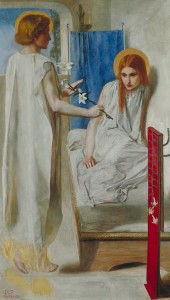In The Bleak Mid-Winter
Published posthumously in 1904, ten years after the death of Christina Rossetti (1830-1894), the poem In the Bleak Mid-Winter would two years later become a plaintive and haunting Christmas carol. Written by Rossetti sometime before 1872, it was not intended as a carol or hymn, but as a Christmas poem at the behest of Scribner’s Monthly, an American literary magazine.
Rossetti was one of the few hymn writers of her day who garnered a reputation as a poet. She was highly supported by an educated and artistic family. Her father came to England as an Italian patriot and refugee who would become a professor at King’s College in London. Her brother, Dante Gabriel Rossetti (1828-1882), was also a poet although he earned greater distinction as a Pre-Raphaelite artist. Possessed of exceptional beauty, Christina often posed as a model for her brother (and other contemporary artists), such as in his unique interpretation of the biblical Annunciation scene with Ecce Ancilla Domini. Sadly she was also known to have suffered her own pain and disappointment, some of which registered as somber verse in the manner of Emily Dickinson, the reclusive American poet.
Gustav Holst (1874-1934), a long-time friend of the celebrated Ralph Vaughan Williams, had a keen interest in Rossetti’s works. Best-known for his classical pieces, notably his orchestral masterpiece The Planets, Holst elevates In the Bleak Mid-Winter with a hymn-like musical setting that was published in the 1906 English Hymnal. Another popular setting for Rossetti’s contemplative poem was produced in 1909 by the English composer, Harold Edwin Darke (1888-1976), while he was a student at the Royal College of Music. His version has been favored by cathedral choirs over the years and it is often featured as part of the Nine Lessons and Carols, the annual Christmas radio broadcast by the King’s College Choir of Cambridge.
Despite England’s long tradition of producing and publishing exceptional carols, In the Bleak Midwinter was voted the greatest Christmas carol of all time in a 2008 poll of English choral experts and choirmasters. This is not at all surprising if your tastes prefer superb Christmas choral singing. Listen closely to the plaintive tune and imagine the gripping scene first depicted in Rossetti’s poem: snow falling on a bitterly cold night, the bleakness of winter, the meager environment attended by a loving and attentive mother in the presence of heavenly angels, stable animals, and lastly a lonely poet humbly offering her heart, her most precious of gifts, to the new-born child Jesus.

